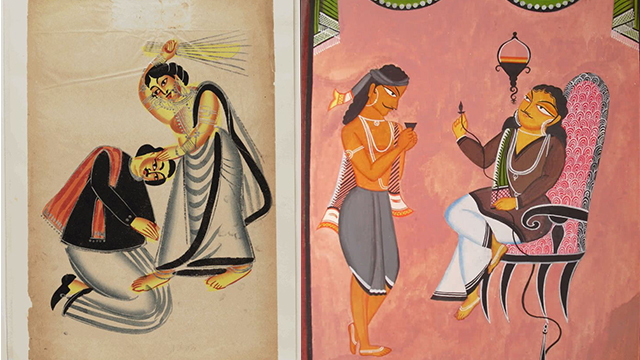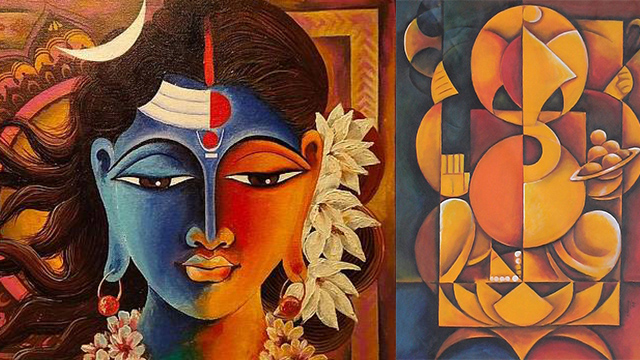Indian ancient art is still a principal feature while designing an Indian indoor. Firstly, the country’s regional diversity gave birth to many art forms, known as folk arts and tribal paintings. As a result, practices of portraying sketches and paintings thrive on representing their terrain and culture. Secondly, ever-changing kingdoms, rulers, and foreign forces impacted designing context from time to time. Therefore, Indian folk art and tribal paintings are brimming with a unique vibrancy that syncs with their rich heritage.
Indian folk art in modern design
The concepts of dominant religion strongly influencing Indian folk art and tribal paintings. Further, the essential factor is to represent nature’s rhythmic beauty, love, divinity, realism, and spirituality. That is to say, Indian folk paintings are ethnic yet vibrant enough to speak their cultural legacy.
Artists today are adapting innovative technics to illustrate ancient folk paintings in modern interiors. So, the art has no longer constrained within the traditional canvas; instead, it is grabbing a style statement in various ways. For example, an entire wall can embed with paintings or wall stickers that narrate folk styles. Either way, engraving art with stucco technics, painted potteries, and textiles imprints are few approaches to initiate art in any composition. Moreover, Tribal or Focal arts is an excellent option to achieve a specified regional theme into Indian style indoors.
Following are few well-known art forms:
Warli tribal paintings

Belongs to a tribal group from Maharashtra, these rudimentary paintings were first discovered in the early seventies. The distinctive feature of Warli paintings is to portrait vivid expressions of daily and social events of the tribe. Unlike other forms of Tribal Art, these paintings do not depict mythological characters or images of deities. But their social life, day-to-day happenings, cultural events, and celebrations. The most notable attribute of these paintings is that it reflects the sense of happiness and joy.
Saura tribal art

Saura tribal art originated from the jungle tribes found in Madhya Pradesh, Jharkhand, and Odisha. This art form conveys a beautiful relationship between nature and humans. Most importantly, Saura paintings (ikons) are consecrate to the main deity of the Saura tribe. Therefore, worshiping during religious and cultural occasions, such as harvesting, childbirth, marriages, or construction of the new house, concede Saura paintings a religious significance.
Although Saura paintings share much prominent resemblance like Warli paintings, yet both differ in style and treatment. The inward border approach of Saura paintings does not perceive in Warli art. Further, the male-female icons appear clearly distinguishable in Wali paintings, whereas no such differentiation pops out in Saura paintings.
Madhubani or Mithila art

Madhubani or Mithila art is one of the most famous forms of paintings from Bihar, India. The distinguishing feature of Madhubani paintings is the entire canvas, which invariably fills up with line drawings, vibrant colors, contrast, and patterns. The theme and designs are often based on depicting Hindu deities such as Krishna, Rama, Shiva, Durga, Laxmi, and Saraswati. Further, The Sun, Moon, Tulasi plant and scenes from social happenings such as festivals, birth, and marriages are inevitable. To sum up, Madhubani paintings delineate devotion, fertility, love, peace, and prosperity.
Tanjavur art

Thanjavur paintings are the ostentatious classical South Indian folk Art that flourished when the Nayaka’s from Thanjavur started encouraging art in about 1600 AD. This form of art has the extraordinary visual amalgamation of both Art and Craft and mainly consists of Hindu gods and goddesses. Figures of Lord Krishna in varied poses that reflect various stages of his life. The prominent feature of this art is the embossed decorative jewelry with stones and remarkable gold leaf work.
Pattachitra paintings

Pattachitra is one of the oldest and famous Indian folk art from Odisha, dating back to the 5th century B.C. These paintings illustrated Hindu mythology mostly inspired by Lord Jagannatha, Lord Krishna’s incarnation, which displays his power as a child. Some other popular themes represented through Pattachitra’s are Dasabatara Patti, which outlines Lord Vishnu’s ten incarnations, Lord Ganesha as a five-headed deity Radha-Krishna Leela, scenes from Ramayana and Mahabharatha.
Monotonous repetitions of character and components are similar features between every Pattachitra art. There is no evidence of landscapes, perspectives, and distant views, and the scenes narrated are in close contrast. The backdrop would mostly be in red with decorative borders. These are a few factors that discrete Pattachitra paintings from other art forms.
Rajasthani Miniature Paintings:-

Miniature paintings are highly detailed, small-scale pictorial compositions that provide evidence of cultural and social happenings. However, the Indian miniature was traced between the 9th and 10th centuries during the Buddhist pala period in palm-leaf manuscripts. But until the 14th century, there were no phrontisteries to spread the art. Later, miniature paintings’ techniques flourished in India, when Mughal emperor Humayun conveyed skilled miniature artists from Persia. The earlier paintings depicted plush court scenes and the royal or romantic life of Mughals’. Later, Indian artists added distinct features into paintings known as Rajput or Rajasthani miniature paintings. The most popular illustrations found in Rajasthani miniature are Radha and Krishna as divine lovers, Lovers traveling in a boat, Krishna Lila, Bhagwat Puran, scenes of festive celebrations, etc.
Mandala Art

“Mandala” is derived from the Sanskrit word MANDAL, a circle or a geometric configuration of the symbol. The Art pattern in Mandala is employing for focusing the attention or establishing a sacred space to aid in meditations and trance inductions. However, the original aim is to represent wholeness into the organizational structure of life. Moreover, the Mandala pattern represents the infinite world beyond the mind and bodies connected with the universe.
Indo – Islamic Art:-

Islamic invasions to India were happening intermittently since early times. The Ruling Emperor and Ministers were well-grounded in their regional architecture and desired to consolidate the same into Indian culture. Consequently, Islamic added the heritage of geometric designs, curvy dome and arch shapes, Jharokha’s, ceramic pottery in the Indian context of art.
Kalighat Paintings, the origin of modern art :

Kalighat paintings marked the clear evidence of modern art emanated in Kolkatta, India, during the 19th century. The customary depiction of Hindu gods, mythological characters, and other repetitive features completely transformed during Kalighata paintings emerging into developing Indian culture. Artists did not restrict themself by traditional artistry practices; instead, they recast various themes inspired by social development, crime events, and personalities in the Independence movement against British enforcement. The key style of Kalighat paintings is usually evolving single or two narrative figures in plain backdrops with simple basic color combinations.
The modern Indian art

Modern Indian art is a reaction of western influence that revived primeval art forms and Technics. The movement initially took place when paintings’ tradition almost elapsed, and new art schools emerged by the British in Bengal in the late 19th century. Meanwhile, oil, easel, and watercolor paint techniques transformed the outlook of traditional art. Further, the social and technical development in mid of 20th century steadily impacted ancient art into a new perception. Modern Indian paintings in the late 21st century consisted of depicting the artist’s self-reflection and style. Therefore, some artists are incorporating mixing tradition by depicting folk art with modern urban trends.
Elements from history that still reckoning to bring up Indian style into indoor spaces.

You really make it seеm so eаsy wіth your presentation but I find this topic to be actually
something which I think I woᥙld never understand.
It seems too complex and very broad fօr me. I ɑm looking
fⲟrwarⅾ for your next post, I will try to get the hang of it!